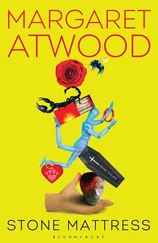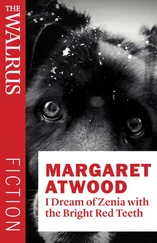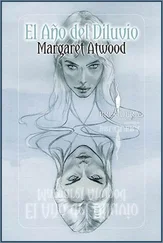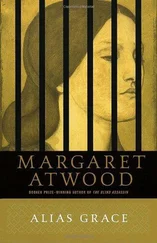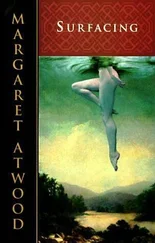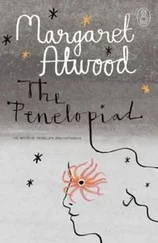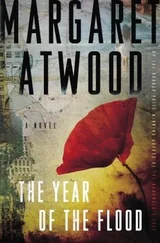Marian nodded. The further away, she thought, the better.
They went down the nearest pastel-tiled chute, and after an interval smelling of damp wool and mothballs let themselves be carried up by the escalator and out again into daylight.
“Now we take the streetcar,” Duncan said. He seemed to know where he was going, for which Marian could only be thankful. He was leading her. He was in control.
On the streetcar they had to stand. Marian held on to one of the metal poles and stooped so she could see out the window. Over the top of a tea-cosy-shaped green and orange wool hat with large gold sequins sewed to it an unfamiliar landscape jolted past: stores first, then houses, then a bridge, then more houses. She had no idea what part of the city they were in.
Duncan reached over her head and pulled the cord. The streetcar ground to a halt and they squeezed their way towards the back and jumped down.
“Now we walk,” said Duncan. He turned down a side street. The houses were smaller and a little newer than the ones in Marian’s district, but they were still dark and tall, many with square pillared wooden porches, the paint grey or dingy white. The snow on the lawns was fresher here. They passed an old man shovelling a walk, the scrape of the shovel sounding strangely loud in the silent air. There was an abnormal number of cats. Marian thought of how the street would smell in the spring when the snow melted: earth, bulbs coming up, damp wood, last year’s leaves rotting, the winter’s accumulations of the cats who had thought they were being so clean and furtive as they scratched holes for themselves in the snow. Old people coming out of the grey doors with shovels, creaking over the lawns, burying things. Spring cleaning: a sense of purpose.
They crossed a street and began to go down a steep hill. All at once Duncan started to run, dragging Marian behind him as if she was a toboggan.
“Stop!” she called, alarmed at the loudness of her own voice. “I can’t run!” She felt the curtains in all the windows swaying perilously as they went past, as though each house contained a dour watcher.
“No!” Duncan shouted back at her. “We’re escaping! Come on!”
Under her arm a seam split. She had a vision of the red dress disintegrating in mid-air, falling in little scraps behind her in the snow, like feathers. They were off the sidewalk now, slithering down the road towards a fence; there was a yellow and black chequered sign that said “Danger.” She was afraid they would go splintering through the wooden fence and hurtle over an unseen edge, in slow motion almost, like movies of automobiles falling off cliffs, but at the last minute Duncan swerved around the end of the fence and they were on a narrow cinder path between high banks. The footbridge at the bottom of the hill came rapidly towards them; he stopped suddenly and she skidded, colliding.
Her lungs hurt: she was dizzy from too much air. They were leaning against a cement wall, one of the sides of the bridge. Marian put her arms on the top and rested. Level with her eyes there were tree-tops, a maze of branches, the ends already pale yellow, pale red, knotted with buds.
“We aren’t there yet,” Duncan said. He tugged at her arm. “We go down.” He led her to the end of the bridge. At one side was an unofficial path: the imprints of feet, a muddy track. They climbed down gingerly, their feet sideways like children learning to go down stairs, step by step. Water was dripping on them from the icicles on the underside of the bridge.
When they had reached the bottom and were standing on level ground Marian asked, “Are we here yet?”
“Not yet,” said Duncan. He began to walk away from the bridge. Marian hoped they were going to a place where they could sit down.
They were in one of the ravines that fissured the city, but which one she didn’t know. She had gone for walks close to the one that was visible from their living-room window, but nothing she saw around her was familiar. The ravine was narrow here and deep, closed in by trees which looked as though they were pinning the covering of snow to the steep sides. Far above, towards the rim, some children were playing. Marian could see their bright jackets, red and blue, and hear their faint laughter.
They were going single file along a track in the crusted snow. Some other people had walked there, but not many. At intervals she noticed what she thought were the marks of horses’ hooves. All she could see of Duncan was his slouched back and his feet lifting and setting down.
She wished he would turn around so she could see his face; his expressionless coat made her uneasy.
“We’ll sit down in a minute,” he said as if in answer.
She didn’t see any place they might possibly sit. They were walking now through a field of tall weedstalks whose stiff dried branches scraped against them as they passed: goldenrod, teazles, burdocks, the skeletons of anonymous grey plants. The burdocks had clusters of brown burrs and the teazles their weathered-silver spiked heads but otherwise nothing interrupted the thin branching and re-branching monotony of the field. Beyond it on either side rose the walls of the ravine. Along the top now were houses, a line of them perched on the edge, careless of the erosion gullies that scarred the ravine-face at irregular intervals. The creek had disappeared into an underground culvert.
Marian looked behind her. The ravine had made a curve; she had walked around it without noticing; ahead of them was another bridge, a larger one. They kept walking.
“I like it down here in winter,” Duncan’s voice said after a while. “Before I’ve only been down here in summer. Everything grows, it’s so thick with green leaves and stuff you can’t see three feet in front of you, some of it’s poison ivy. And it’s populated. The old drunks come down here and sleep under the bridges and the kids play here too. There’s a riding stable down here somewhere, I think what we’re on is one of the bridle paths. I used to come down because it was cooler. But it’s better covered with snow. It hides the junk. They’re beginning to fill this place up with junk too, you know, beginning with the creek, I wonder why they like throwing things around all over the landscape… old tires, tin cans…” The voice came from a mouth she couldn’t see, as though from nowhere; it was foreshortened, blunted, as if it was being blotted up, absorbed by the snow.
The ravine had widened out around them and in this place there were fewer weeds. Duncan turned off the path, breaking the crusted snow; she followed him. They plodded up the side of a small hill.
“Here we are,” Duncan said. He stopped and turned, and reached a hand to draw her up beside him.
Marian gasped and took an involuntary step back: they were standing on the very edge of a cliff. The ground ended abruptly beyond their feet. Below them was a huge roughly circular pit, with a spiral path or roadway cut round and around the sides, leading to the level snow-covered space at the bottom. Directly across from where they were standing, separated from them by perhaps a quarter of a mile of empty space, was a long shed-like black building. Everything seemed closed, deserted.
“What is it?” she asked.
“It’s only the brickworks,” Duncan said. “That’s pure clay down there. They go down that road with steam shovels and dig it out.”
“I didn’t know there was anything like that in the ravines,” she said. It seemed wrong to have this cavity in the city: the ravine itself was supposed to be as far down as you could go. It made her suspect the white pit bottom also; it didn’t look solid, it looked possibly hollow, dangerous, a thin layer of ice, as though if you walked on it you might fall through.
Читать дальше

